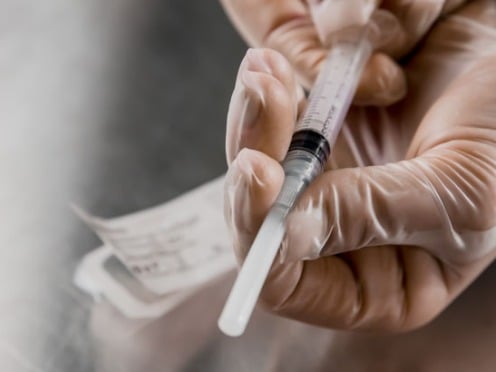
Top insights from the Endpoints at ASCO McKesson leadership panel
How McKesson’s flu vaccine team mobilized to prepare for a potential flu and COVID-19 “twindemic”.

Read time: 5 minutes
Unprecedented. It’s the word that many people have used to define the past year and a half, and one that also reflects a number of “firsts” across many industries. This undoubtedly rings true for the team that oversees McKesson’s seasonal flu vaccine program.
During last year’s flu season (2020-2021), McKesson sent roughly 19% more doses of flu vaccines to customers throughout the U.S. than it did the previous season.
That’s more than the company – the country’s largest distributor of seasonal flu vaccines – has ever distributed throughout any given season in its history.
“Even in the season immediately following the H1N1 flu pandemic in 2009, we didn’t send that many seasonal flu doses,” says Omar Bateh, director of vaccines, McKesson Medical-Surgical. “This was a new record.”
It’s a feat that certainly wasn’t part of McKesson’s original plan going into last year. But then COVID-19 hit.
No two flu seasons are alike. As flu strains mutate year over year, so too do infection rates, severity, vaccine efficacy and, consequently, the number of vaccines needed throughout the country.
“We have this saying in the industry – ‘If you’ve seen one flu season, you’ve seen one flu season,” quips Jon Schwarze, director of vaccines, Pharmaceutical Solutions and Services, McKesson. “Every flu season brings something different. We have our processes, but it really boils down to being agile and ready to handle whatever happens. That’s never been truer than it is this year.”
Every spring, McKesson begins the process of negotiating distribution agreements with vaccine manufacturers. These agreements culminate from months of close planning that starts with manufacturers, who begin the year with a baseline number of vaccines they plan to develop. McKesson then works with its customers – hospitals, physicians’ offices and retail pharmacies – to pre-book the number of vaccines they plan to administer for the upcoming season. By March of 2020, McKesson had already completed this part of the process and was prepared to distribute a similar number of doses as it did during the previous one.
But then COVID-19 began spreading through the country the same month. Faced with the threat of flu season and COVID-19 combining to create a “twindemic,” McKesson realized it needed to re-evaluate the number of doses its customers would require to help protect people throughout what could have been an extremely challenging respiratory season.
With the possibility of higher demand, avoiding a vaccine shortage meant McKesson had to go back to the drawing board with manufacturers and customers – and fast.
“Manufacturers can’t just flip the switch and start making more flu vaccines when demand changes,” Bateh explains. “Typically, it takes them about seven to eight months to grow, fill and finish a flu vaccine, and then also get FDA approval on that lot before it can be released for distribution.”
The McKesson team contacted its customers to communicate these unforeseen variables potentially impacting their success in the season ahead. As a result, additional pre-booking demand for flu vaccines in the U.S. market went up significantly. For retail pharmacy customers, requests soared.
“We have this saying in the industry – ‘If you’ve seen one flu season, you’ve seen one flu season.’ […] That’s never been truer than it is this year.”
To meet this surge in demand, McKesson went back to the manufacturers and the Centers for Disease Control and Prevention (CDC) to forecast how many additional vaccines needed to be produced. It also evaluated the timetable to deliver them once ready – an event that usually happens between July and September each year. With additional lots potentially not ready until November or December of 2020, McKesson needed to account for not only an extended distribution timeline to continue supporting demand throughout the season, but also the possibility that the COVID-19 pandemic could directly impact where those doses would be most needed.
Historically, the majority of patients get their flu shot during annual check-ups at their doctor’s office. With social distancing measures in place, however, Schwarze and Bateh anticipated those typical behaviors could change as well.
“In the event we experienced a spike in COVID-19 cases last flu season, we knew people might not go to their physicians’ offices for a routine visit, meaning they wouldn’t be getting vaccinated there,” Bateh says. “But they might still go to a retail location or a local pharmacy to get their flu shot. So we were closely monitoring our inventory in case we needed to shift doses across our supply chains to make sure they were going to the appropriate place at the appropriate time.”
Schwarze added that his team has always utilized an inventory sequestration tool that’s integrated across all McKesson distribution centers. As potential customer supply needs arise, McKesson can move any unused flu vaccines across the supply chain to those who need it.
As Bateh and Schwarze had anticipated, pharmacies handled a surge in vaccinations during the 2020-2021 season. By the first week of October alone, they had experienced a 72% increase in vaccinations over the same time in 2019, according to October 2020 IQVIA data. And McKesson’s teams continued to meet this record demand all season long – a testament to their ability to mobilize when plans change.
The CDC recently announced the beginning of the U.S.’ 2021-2022 flu season. And while last season fortunately turned out to be an extremely mild one, experts are being particularly vocal on the importance of getting vaccinated this season, which they predict to be much more severe.
For its part, McKesson is on track to meet the new demands of the current season. That’s because in a time of virtually no constants, the two that have carried McKesson’s flu vaccine team to success in the past are the same that have helped them do so throughout two flu seasons during COVID-19 – a versatile and adaptive supply chain, and continuous communication with customers, with industry partners, and with each other throughout every step of the process.
“You might think that because of COVID-19 we’re doing things very differently,” says Schwarze. “But from an operational standpoint, we’re doing it the same way we always have – leveraging everything that our supply chain and team of experts can offer so we can help our customers succeed during flu season – pandemic or not.”